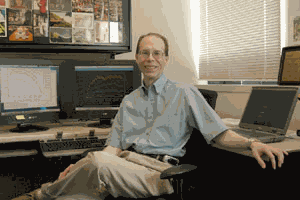Michael Borland, Operations Analysis Group Leader in the Accelerator Systems Division of the Advanced Photon Source (APS), is one of four Argonne employees to be presented with a Distinguished Performance Award for 2007. Borland, who was recently named APS Supervisor of the Year, was nominated for his work in “the development and implementation of software for accelerator research that is recognized internationally and that represents groundbreaking achievements in the field of computational accelerator physics,” according to Efim Gluskin, Accelerator Systems Division Director.
The University of Chicago Distinguished Performance Awards, which recognize outstanding scientific or technical achievements, or a distinguished record of achievement, by select Argonne employees, are presented by the UChicago Argonne, LLC Board of Governors.
Borland, who has been with the APS since 1991, began his work in accelerator-related software nearly 20 years ago. His best-known work, named elegant (electron generation and tracking), is an accelerator simulation code that provides physicists with a flexible tool to design and understand linear accelerators and storage rings. elegant, the primary tool at the APS for accelerator design and simulation, was used to develop the present APS storage ring lattice (the configuration of magnet strengths) that is producing an electron beam with the record low emittance and reduced horizontal beam size that are vital to providing users with a reliable supply of x-ray beams.
elegant has also been used to validate the safety strategy for the “top-up” storage ring operating mode perfected at the APS and now in use at light sources worldwide. It was the first integrated accelerator code with a fast, realistic model of coherent synchrotron radiation effects on electron beams, leading to the discovery—in collaboration with the Stanford Linear Accelerator Center (SLAC)—of a potentially serious instability in the design of the Linac Coherent Light Source, the fourth-generation light source under construction at SLAC. elegant was also used with other codes to perform the first-ever start-to-end jitter simulations of an x-ray free-electron laser. By virtue of its unique features, elegant is used world-wide by accelerator physicists designing short-wavelength free-electron lasers and energy recovery linacs.
In his role as Leader for Accelerator Design in the APS upgrade effort, Borland leads the development of upgrade options ranging from replacement storage rings to energy recovery linacs, all using elegant as the sole accelerator code. “As we prepare for an upgrade to the APS in the next decade, Michael’s knowledge and leadership in accelerator design and modeling are a trump card for Argonne,” Said Murray Gibson, Argonne Associate Laboratory Director for Scientific User Facilities and Director of the APS.
Borland, together with Ernst Rehm (Physics Division), Michael Wang (Center for Transportation Research), and Linda Young (Chemistry Division), will receive his award at formal ceremonies held on June 28.
Argonne is a U.S. Department of Energy laboratory managed by UChicago Argonne, LLC

